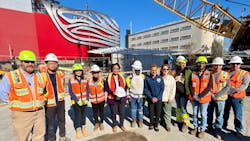L.A. Metro completes tunneling for Purple Subway Extension Project
The Los Angeles County Metropolitan Transportation Authority (L.A. Metro) has completed tunneling for the Purple (D Line) Subway Extension Project.
"This safe completion of tunneling through this part of Los Angeles is a milestone in L.A. Metro’s work to expand fast and reliable public transit across the region," said Los Angeles Mayor and L.A. Metro Board Chair Karen Bass. "When completed, the D Line extension will make L.A. Metro transit available to 53,300 more weekday riders traveling between downtown Los Angeles and the Westside. Thank you to all of the construction workers who have given their time and talent to successfully complete the tunneling."
With the completion of tunneling, L.A. Metro will continue to work with its two contractors as part of a joint venture with Skanska-Traylor-Shea and Tutor-Perini/O&G to complete seven new underground stations in Section 1 between Wilshire/Western and Wilshire/La Cienega, Section 2 between Wilshire/La Cienega and Century City and Section 3 between Century City and Westwood.
Contractors utilized the latest Tunnel Boring Machine (TBM) technology to excavate approximately 40 to 60 feet per day to help complete tunneling for the project. The 400 foot-long, 21 foot-diameter earth digging machines utilized closed face, pressurized TBM technology that minimizes ground settlement during excavation. The machines also lined the tunnel itself with precast concrete segments that were bolted together to form secure rings making them water- and gas-tight, preventing water and gas-related risks. The same TBM technology was successfully employed on L.A. Metro’s 2009 Eastside Extension Project.
"The D Line Subway Extension is one of the most complex engineering feats that L.A. Metro has undertaken," said Lindsey Horvath, chair of the Los Angeles County Board of Supervisors and L.A. Metro Board member. "Its complexity is matched by the immense value the project will bring to Los Angeles when it opens and carries 30,000 daily riders through one of our densest and most job-rich regions."
During its five years of tunneling, L.A. Metro faced and successfully overcame many technical challenges, including gassy ground, tar sands and abandoned oil wells. Near the La Brea Tarpits, L.A. Metro’s advanced TBMs made their way through tar sands and used horizontal directional drillings to probe the earth so contractors could identify and remove potential objects before any TBM damage occurred. The agency also safely used the same methods to identify and avoid unmapped and abandoned oil wells underneath Beverly Hills High School.
"Congratulations to L.A. Metro and its contractors for reaching a critical milestone for the D Line Subway Extension," said Los Angeles County supervisor and L.A. Metro Board member Holly J. Mitchell. "We are one major step closer to a Los Angeles where everyone has access to all the cultural and economic resources the region has to offer."
"Now that tunneling is complete, it won’t be long before L.A. Metro completes this mega-project and makes it possible for everyone to travel from downtown L.A. to western L.A. in under 30 minutes," said Katy Yaroslavsky, Los Angeles City Council member and L.A. Metro Board member. "This subway extension will catalyze ridership on the entire L.A. Metro system in the years ahead, bringing many thousands of new riders throughout L.A. Metro’s transit system."
The project is extending L.A. Metro’s D Line subway from its current terminus at Wilshire/Western for nine miles to the Westwood VA Hospital in Westwood, Calif. The project is funded mostly by the 2008 Measure R and 2016 Measure M voter-approved transportation sales text measures. The local funding sources were then matched by federal funding, which amounted to approximately half of the project’s overall cost. Section 1 of the project is forecast to open in 2025, with Section 2 projected to open in 2026 and Section 3 in 2027.
"The end of tunneling work on this project is a triumph of engineering, planning and execution. Our construction team undertook a painstaking process that helped us keep everyone in these communities safe and deliver a better project for the people of L.A. County," said Stephanie Wiggins, L.A. Metro CEO. "We have proven yet again our capability to safely tunnel underneath a range of different structures, as well as sensitive and historic sites."
